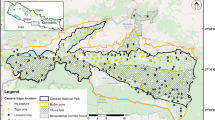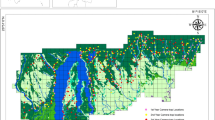Abstract
Large carnivores are vulnerable to population decline due to their k-selected traits in fragmented human-dominated landscapes. In the semi-arid landscape of western India, tiger (top predator) populations went locally extinct from most of the forested ecosystems, while the mesopredators (leopards, hyenas, wolves) managed to survive in these mosaics of forest, agriculture, pasturelands, ravines, and human habitations. In this study, we used camera traps to survey two protected areas (PAs) in the semi-arid western Indian landscape—Mukundara (without tigers) and Ranthambhore (with high-density tiger population)—and compare the abundance and activity of mesopredators between sites to assess the effect of top predator presence on mesopredators. The carnivore community was more diverse in Ranthambhore (well-protected) than in the human disturbed habitats of Mukundara; however, the relative abundance of mesopredators was higher in Mukundara. Striped hyena density was estimated higher in Mukundara (40.6 ± 7.36/100 km2) than in Ranthambhore (9.3 ± 1.3/100 km2), while leopard density estimates were comparable (Mukundara, 10.9 ± 3.0/100 km2; Ranthambhore, 11.2 ± 1.6/100 km2). Temporal activities of carnivores in Mukundara indicated avoidance of human disturbance, while in Ranthambhore, it seemed primarily governed by competitive interactions between carnivores. Our findings are indicative of the mesopredator release hypothesis, where the number of mesopredators increased in the absence of top predator; however, the results are confounded by differential resource availability, human disturbance, and poaching levels between sites. The outcomes emphasised the importance of conserving habitat fragments (irrespective of charismatic species’ presence) in human-dominated landscapes to conserve carnivore populations. Conservation investments should focus on habitat protection, securing inviolate areas inside the PAs and restoring connectivity between PAs.


Similar content being viewed by others
Data availability
Species photo-captured in the camera traps are in Schedule I of the Indian Wildlife Protection Act (1972) and prone to wildlife trade; therefore, precise locations cannot be made publicly available. All other data are either in the main paper or in the supplementary material.
References
Alam MS, Khan JA, Pathak BJ (2015) Striped hyena (Hyaena hyaena) status and factors affecting its distribution in the Gir National Park and Sanctuary. India J Vertebr Biol 64(1):32–39
Athreya V, Odden M, Linnell JD, Krishnaswamy J, Karanth U (2013) Big cats in our backyards: persistence of large carnivores in a human dominated landscape in India. PLoS ONE 8(3):e57872
Banerjee K, Jhala YV, Chauhan KS, Dave CV (2013) Living with lions: the economics of coexistence in the Gir forests, India. Plos One 8(1):e49457
Balme GA, Hunter LT, Slotow ROB (2009) Evaluating methods for counting cryptic carnivores. J Wildl Manag 73(3):433–441
Beschta RL, Ripple WJ (2019) Can large carnivores change streams via a trophic cascade? Ecohydrology 12(1):e2048
Bopanna IP (2013) Habitat use, ranging pattern and food habits of striped hyaena (Hyaena hyaena) in Kutch, Gujarat. PhD thesis, Saurashtra University, Rajkot, India
Borchers DL, Efford MG (2008) Spatially explicit maximum likelihood methods for capture–recapture studies. Biometrics 64(2):377–385
Broekhuis F, Gopalaswamy AM (2016) Counting cats: Spatially explicit population estimates of cheetah (Acinonyx jubatus) using unstructured sampling data. PLoS ONE 11(5):e0153875
Brooke ZM, Bielby J, Nambiar K, Carbone C (2014) Correlates of research effort in carnivores: body size, range size and diet matter. PLoS ONE 9(4):e93195
Burnham KP, Anderson DR (2003) Model selection and multimodel inference: a practical information-theoretic approach. Springer Science & Business Media
Burton AC, Neilson E et al (2015) Wildlife camera trapping: a review and recommendations for linking surveys to ecological processes. J Appl Ecol 52(3):675–685
Carbone C, Christie S et al (2001) The use of photographic rates to estimate densities of tigers and other cryptic mammals. Anim Conserv 4(1):75–79
Champion SH, Seth SK (1968) A revised survey of the forest types of India. Dehli: Manager of Publications
Chapron G, Kaczensky P et al (2014) Recovery of large carnivores in Europe’s modern human-dominated landscapes. Science 346(6216):1517–1519
Check E (2006) The tiger’s retreat. Nature 441:927–30
Crooks KR (2002) Relative sensitivities of mammalian carnivores to habitat fragmentation. Conserv Biol 16(2):488–502
Efford MG (2012) SECR-spatially explicit capture-recapture in R. http://www.otago.ac.nz/density/pdfs/secr-overview%202.3.1.pdf
Gese EM (2001) Monitoring of terrestrial carnivore populations. CONSERVATION BIOLOGY SERIES-CAMBRIDGE- 372–396
Gogoi K, Kumar U, Banerjee K, Jhala YV (2020) Spatially explicit density and its determinants for Asiatic lions in the Gir forests. PLoS ONE 15(2):e0228374
Gomez L, Wright B, Shepherd CR, Joseph T (2021) An analysis of the illegal bear trade in India. Global Ecology and Conservation 27:e01552
Gopal R, Qureshi Q, Bhardwaj M, Singh RJ, Jhala YV (2010) Evaluating the status of the endangered tiger Panthera tigris and its prey in Panna Tiger Reserve, Madhya Pradesh. India Oryx 44(3):383–389
Gupta S, Mondal K, Sankar K, Qureshi Q (2009) Estimation of striped hyena hyaena population using camera traps in Sariska Tiger Reserve, Rajasthan. India J Bombay Nat Hist Soc 106(3):284
Hanski I, Gilpin M (1991) Metapopulation dynamics: brief history and conceptual domain. Biol J Lin Soc 42(1–2):3–16
Harihar A, Pandav B, Goyal SP (2011) Responses of leopard Panthera pardus to the recovery of a tiger Panthera tigris population. J Appl Ecol 48(3):806–814
Harihar A, Ghosh M, Fernandes M, Pandav B, Goyal SP (2010) Use of photographic capture-recapture sampling to estimate density of striped hyena (Hyaena hyaena): implications for conservation
Jennelle CS, Runge MC, MacKenzie DI (2002) The use of photographic rates to estimate densities of tigers and other cryptic mammals: a comment on misleading conclusions. Anim Conserv 5(2):119–120. Cambridge University Press
Jhala YV (2002) Cattle and carnivores. The National Wildlife Federation. Available online at: https://www.nwf.org/en/Magazines/National-Wildlife/2002/Cattle-and-Carnivores
Jhala YV (2003) Status, ecology and conservation of the Indian wolf Canis lupus pallipes Sykes. J Bombay Nat Hist Soc 100(2):3
Jhala YV (2015a) Indian wolf (Canis lupus pallipes); in Mammals of South Asia Johnsingh AJT, & Manjrekar N (Eds.) Universities Press (India), 377–391
Jhala YV (2015b) Striped hyena (Hyaena hyaena); in Mammals of South Asia Johnsingh AJT, Manjrekar N (Eds.) Universities Press (India), 522–530
Jhala Y, Qureshi Q, Gopal R (2011) Can the abundance of tigers be assessed from their signs? J Appl Ecol 48(1):14–24
Jhala YV, Qureshi Q, Gopal R (2010) The status of tigers in India 2010. National Tiger Conservation Authority, New Delhi and Wildlife Institute of India, Dehradun
Kalle R, Ramesh T, Qureshi Q, Sankar K (2011) Density of tiger and leopard in a tropical deciduous forest of Mudumalai Tiger Reserve, southern India, as estimated using photographic capture–recapture sampling. Acta Theriol 56(4):335–342
Karanth KU, Nichols JD (1998) Estimation of tiger densities in India using photographic captures and recaptures. Ecology 79(8):2852–2862
Kumar U, Awasthi N, Qureshi Q, Jhala Y (2019) Do conservation strategies that increase tiger populations have consequences for other wild carnivores like leopards? Sci Rep 9(1):1–8
Latafat K, Sadhu A (2016) First photographic evidence of Indian Pangolin (Manis crassicaudata Gray 1827) in Mukundara Hills Tiger Reserve (MHTR), Rajasthan, India. J Bombay Nat Hist Soc 113(2)
Meredith M, Ridout M (2014) Overview of the overlap package. R Project 1–9
Mills MGL, Hofer H (1998) Hyaenas. Status survey and conservation action plan. IUCN/SSC Hyaena Specialist Group. IUCN, Gland, Switzerland and Cambridge, UK
Mandal D, Basak K, Mishra RP, Kaul R, Mondal K (2017) Status of leopard Panthera pardus and striped hyena Hyaena and their prey in Achanakmar Tiger Reserve, Central India. J Zool Stud 4(4):34–41
Mondal K, Gupta S, Bhattacharjee S, Qureshi Q, Sankar K (2012) Response of leopards to re-introduced tigers in Sariska Tiger Reserve, Western India. Int J Biodivers Conserv 4(5):228–236
O'Brien TG, Kinnaird MF, Wibisono HT (2003) Crouching tigers, hidden prey: Sumatran tiger and prey populations in a tropical forest landscape. Anim Conserv 6(2):131–139. Cambridge University Press
Odden M, Athreya V, Rattan S, Linnell JD (2014) Adaptable neighbours: movement patterns of GPS-collared leopards in human dominated landscapes in India. PLoS ONE 9(11):e112044
Prugh LR, Stoner CJ et al (2009) The rise of the mesopredator. Bioscience 59(9):779–791
R Core Team (2017) R: A language and environment for statistical computing. R Foundation for Statistical Computing. Vienna, Austria. http://www.R-projectorg/
Ripple WJ, Wirsing AJ, Wilmers CC, Letnic M (2013) Widespread mesopredator effects after wolf extirpation. Biol Cons 160:70–79
Ripple WJ, Estes JA et al (2014) Status and ecological effects of the world’s largest carnivores. Science 343(6167):1241484
Ritchie EG, Johnson CN (2009) Predator interactions, mesopredator release and biodiversity conservation. Ecol Lett 12(9):982–998
Rodgers WA, Panwar HS (1988) Planning a protected area network in India. Wildlife Institute of India, Dehradun 1
Roemer GW, Gompper ME, Van Valkenburgh B (2009) The ecological role of the mammalian mesocarnivore. Bioscience 59(2):165–173
Sadhu A, Gupta D, Latafat K, Jambu N, George S, Jhala YV, Qureshi Q (2015) Chapters - Ranthambhore Tiger Reserve; and Mukundara Hills Tiger Reserve in: The Status of tigers, copredators and prey in India 2014. https://ntca.gov.in/assets/uploads/Reports/AITM/AITE_2014_fullreport.pdf
Sadhu A, Jayam PPC, Qureshi Q, Shekhawat RS, Sharma S, Jhala YV (2017) Demography of a small, isolated tiger (Panthera tigris tigris) population in a semi-arid region of western India. BMC Zoology 2(1):1–13
Singh P, Gopalaswamy AM, Karanth KU (2010) Factors influencing densities of striped hyenas (Hyaena hyaena) in arid regions of India. J Mammal 91(5):1152–1159
Singh P, Reddy GV (2016) Lost tigers plundered forests: A report tracing the decline of the tiger across the state of Rajasthan (1900 to present). New Delhi: WWF-India
Sollmann R, Furtado MM, Gardner B, Hofer H, Jácomo AT, Tôrres NM, Silveira L (2011) Improving density estimates for elusive carnivores: accounting for sex-specific detection and movements using spatial capture–recapture models for jaguars in central Brazil. Biol Cons 144(3):1017–1024
Soulé ME, Bolger DT, Alberts AC, Wrights J, Sorice M, Hill S (1988) Reconstructed dynamics of rapid extinctions of chaparral-requiring birds in urban habitat islands. Conserv Biol 2(1):75–92
Swanson A, Arnold T, Kosmala M, Forester J, Packer C (2016) In the absence of a “landscape of fear”: How lions, hyenas, and cheetahs coexist. Ecol Evol 6(23):8534–8545
Tobler MW, Powell GV (2013) Estimating jaguar densities with camera traps: problems with current designs and recommendations for future studies. Biol Cons 159:109–118
Yoganand K (2005) Behavioural ecology of sloth bear (Melursus ursinus) in Panna National Park, Central India. PhD Thesis. Saurashtra University, India
Acknowledgements
We thank the National Tiger Conservation Authority, Wildlife Institute of India, and Forest Department of Rajasthan for the necessary permission, support, and logistics. We want to thank all India Tiger Estimation team (2014) and our field assistants for assisting in data collection. We thank Vaishnavi Gussain for the map preparation.
Funding
This research was funded by the National Tiger Conservation Authority, Government of India (Grant released under NTCA AITE/2013–14).
Author information
Authors and Affiliations
Contributions
Yadvendradev V Jhala and Kainat Latafat conceptualised the study. Yadvendradev V Jhala and Qamar Qureshi supervised the study and arranged necessary permissions and funds. Kainat Latafat and Ayan Sadhu conducted the fieldwork. Kainat Latafat and Ayan Sadhu perform the data analyses. Kainat Latafat, Ayan Sadhu and Yadvendradev V Jhala drafted the manuscript. All authors reviewed and approved the final manuscript.
Corresponding author
Ethics declarations
Competing interests
The authors declare no competing interests.
Additional information
Publisher's Note
Springer Nature remains neutral with regard to jurisdictional claims in published maps and institutional affiliations.
Supplementary Information
Below is the link to the electronic supplementary material.
Rights and permissions
Springer Nature or its licensor (e.g. a society or other partner) holds exclusive rights to this article under a publishing agreement with the author(s) or other rightsholder(s); author self-archiving of the accepted manuscript version of this article is solely governed by the terms of such publishing agreement and applicable law.
About this article
Cite this article
Latafat, K., Sadhu, A., Qureshi, Q. et al. Abundance and activity of carnivores in two protected areas of semi-arid western India with varying top predator density and human impacts. Eur J Wildl Res 69, 15 (2023). https://doi.org/10.1007/s10344-023-01643-9
Received:
Revised:
Accepted:
Published:
DOI: https://doi.org/10.1007/s10344-023-01643-9




